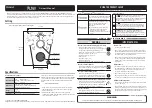
58
O&M Manual
Rev-J (11/18)
Part 9 – System Maintenance
9.1
General
The Q46H/65 Chlorine Dioxide System will generally provide unattended operation over long
periods of time. With proper care, the system should continue to provide measurements
indefinitely. For reliable operation, maintenance on the system must be done on a regular
schedule. Keep in mind that preventive maintenance on a regular schedule is much less
troublesome than emergency maintenance that always seems to come at the wrong time.
9.2
Analyzer Maintenance
No unusual maintenance of the analyzer is required if installed according to the guidelines of this
operating manual. If the enclosure door is frequently opened and closed, it would be wise to
periodically inspect the enclosure sealing gasket for breaks or tears.
9.3
Sensor Maintenance
Sensor maintenance is required for accurate measurements. The primary requirement is simply
to keep the sensor membrane clean. The membrane is a solid polymer that is resistant to
anything that will be encountered in water streams. However, deposits can form on the surface of
the membrane, and these deposits will reduce the sensitivity. Certain constituents in water,
mainly iron and manganese, will for precipitates when the water is ozonated. These precipitates
can sometimes form a coating on the membrane.
Because membranes are relatively impermeable, they are relatively easy to clean. effectively.
Often, it is sufficient to simply wipe the membrane with a soft cloth or paper towel. Immersing the
tip of the sensor in 1N nitric acid solution will sometimes remove deposits that cause low
sensitivity, but this is not always the case. If deposits do not easily wipe off or come off with acid
soaking, simply replace the membrane. To change a membrane, follow the Sensor Assembly
procedure (see section 5.1). Do not reuse the electrolyte from the sensor when changing a
membrane. Always refill with fresh electrolyte. The electrolyte is stable and does not have a
limited shelf life.
Refer again to the explanation of the sensor slope number after an accepted span calibration on
the lower MEASURE screen. In normal operation, the slope of the sensor output will decrease
over time as the membrane becomes fouled. This reduction indicates that the sensor is losing
sensitivity to ClO
2
. It is good practice to replace the membrane if the slope number falls to 30-
40%. The value will not go below 20%.
Even if no buildup is apparent on the membrane, it should be changed on a regular schedule.
The recommended membrane change interval is every 6 months. For high purity water
applications, this can probably be extended if desired, but a more frequent changing interval is a
small price to pay for avoiding membrane failure at the wrong time.
While the sensor is disassembled for membrane changing, examine the condition of the o-rings
on both ends of the electrolyte chamber. If the o-rings show any signs of damage, replace them
with new ones from the spare parts kit. It is good practice to change these o-rings once a year,
regardless of their condition
.













































